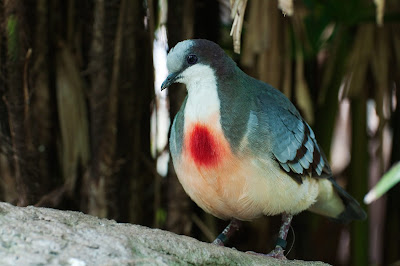Belongs within: Acanthoideae.
Lepidagathis is a pantropical genus of shrubs and subshrubs with flowers borne in dense spikes or thyrses.
Characters (from Kameyama 2008): Small decumbent to erect subshrubs, or erect to sprawling shrubs. Inflorescences simple (thyrse or spike) or compound indeterminate; most commonly secundiflorous spikes with two rows of sterile bracts and two rows of fertile bracts. Calyx zygomorphic, formed by five unequal sepals, lateral ones narrower and very often shorter than others, posterior or upper sepal wider, two anterior sepals generally fused to each other to greater extent than with lateral sepals. Corolla bilabiate, upper lip entire or shallowly bilobed, lower lip trilobed. Two or four fertile stamens, anterior anthers bithoecous, posterior anthers (if present) mono- or bithecous or reduced to staminodia. Pollen 3-colporate, reticulate, heterobrochate, lumina verrucate, pilate or baculate. Ovary with two ovules at each locule; stigma subcapitate, shallowly bilobed; nectariferous disk cupulate, covering one quarter to almost half of ovary; base of style with ring of long, straight hairs. Capsule outline oblong, elliptic to ovate, apex acute to acuminate, subquadrangular, with relatively thin walls and thick septum, usually with four seeds (sometimes two). Seeds lenticular, with hygroscopic trichomes that expand when moist.
Lepidagathis Willdenow 1800 K08 (see below for synonymy)
|--*L. cristata Willdenow 1800 K08
|--L. alopecuroides K08
|--L. alvarezia K08
|--L. aristata E09
|--L. bandraensis PP07
|--L. callistachys Kameyama 2008 K08
|--L. chiapensis (Acosta) Kameyama 2008 [=Lophostachys chiapensis Acosta 1985] K08
|--L. cuneiformis Kameyama 2008 K08
|--L. cyanea (Leonard) Kameyama 2008 [=Lophostachys cyanea Leonard 1959] K08
|--‘Lophostachys’ falcata SV00
|--L. fasciculata VD03
|--L. floribunda [=Lophostachys floribunda Pohl 1831] K08
|--L. grandidieri K08
|--L. guatemalensis (Donn. Sm.) Kameyama 2008 [=Lophostachys guatemalensis Donn. Sm. 1901] K08
|--L. hyalina SV00
|--L. laxifolia (Nees) Kameyama 2008 (see below for synonymy) K08
|--L. meridionalis Kameyama 2008 K08
|--L. montana (Mart.) Kameyama 2008 (see below for synonymy) K08
|--L. nemoralis (Mart. ex Nees) Kameyama 2008 (see below for synonymy) K08
|--L. paraensis Kameyama 2008 K08
|--L. pohliana K08
|--L. pseudoaristata Ensermu 2009 E09
|--L. riedeliana K08
|--L. scariosa SR07
|--L. sessilifolia [=Lophostachys sessilifolia Pohl 1831] K08
|--L. soconuscana (Daniel) Kameyama 2008 [=Lophostachys soconuscana Daniel 1993] K08
|--L. trinervis PP07
|--L. uxpanapensis (Acosta) Kameyama 2008 [=Lophostachys uxpanapensis Acosta 1985] K08
|--L. villosa Hedrén 1993 K08
`--L. wasshausenii Kameyama 2008 K08
Lepidagathis Willdenow 1800 K08 [incl. Apolepsis SV00, Lindauea SV00, Liberatia SV00, Lophostachys Pohl 1831 K08, Teliostachya Nees 1847 K08, Volkensiophyton SV00]
Lepidagathis laxifolia (Nees) Kameyama 2008 [=Lophostachys laxifolia Nees in Wall. 1832; incl. Lo. patula Mart. ex Nees in Mart. 1847] K08
Lepidagathis montana (Mart.) Kameyama 2008 [=Lophostachys montana Mart. ex Nees in Mart. 1847; incl. Lo. villosa Pohl 1831 non Lepidagathis villosa Hedrén 1993] K08
Lepidagathis nemoralis (Mart. ex Nees) Kameyama 2008 [=Lophostachys nemoralis Mart. ex Nees in Mart. 1847; incl. Lo. semiovata var. minor Nees in Mart. 1847, Lo. semiovata Nees in Mart. 1847] K08
*Type species of generic name indicated
REFERENCES
[E09] Ensermu K. 2009. Three new species of Acanthaceae from Ethiopia. Kew Bulletin 64 (1): 57–65.
[K08] Kameyama, C. 2008. New species, nomenclatural changes and lectotypifications in Neotropical Lepidagathis Willd. (Acanthaceae). Kew Bulletin 63 (4): 565–581.
[PP07] Pandey, R. P., & P. M. Padhye. 2007. Studies on phytodiversity of Arid Machia Safari Park-Kailana in Jodhpur (Rajasthan). Bulletin of the Botanical Survey of India 49: 15–78.
[SR07] Sankar, R. V., K. Ravikumar, N. M. Ganesh Babu & D. K. Ved. 2007. Botany of Anapady MPCA, Palghat district, Kerala with special emphasis on species of conservation concern. Bulletin of the Botanical Survey of India 49: 165–172.
[SV03] Scotland, R. W., & K. Vollesen. 2000. Classification of Acanthaceae. Kew Bulletin 55 (3): 513–589.
[VD03] Venu, P., & P. Daniel. 2003. Is Hemigraphis venosa C.B. Clarke (Acanthaceae) extinct? Bulletin of the Botanical Survey of India 45: 91–96.









